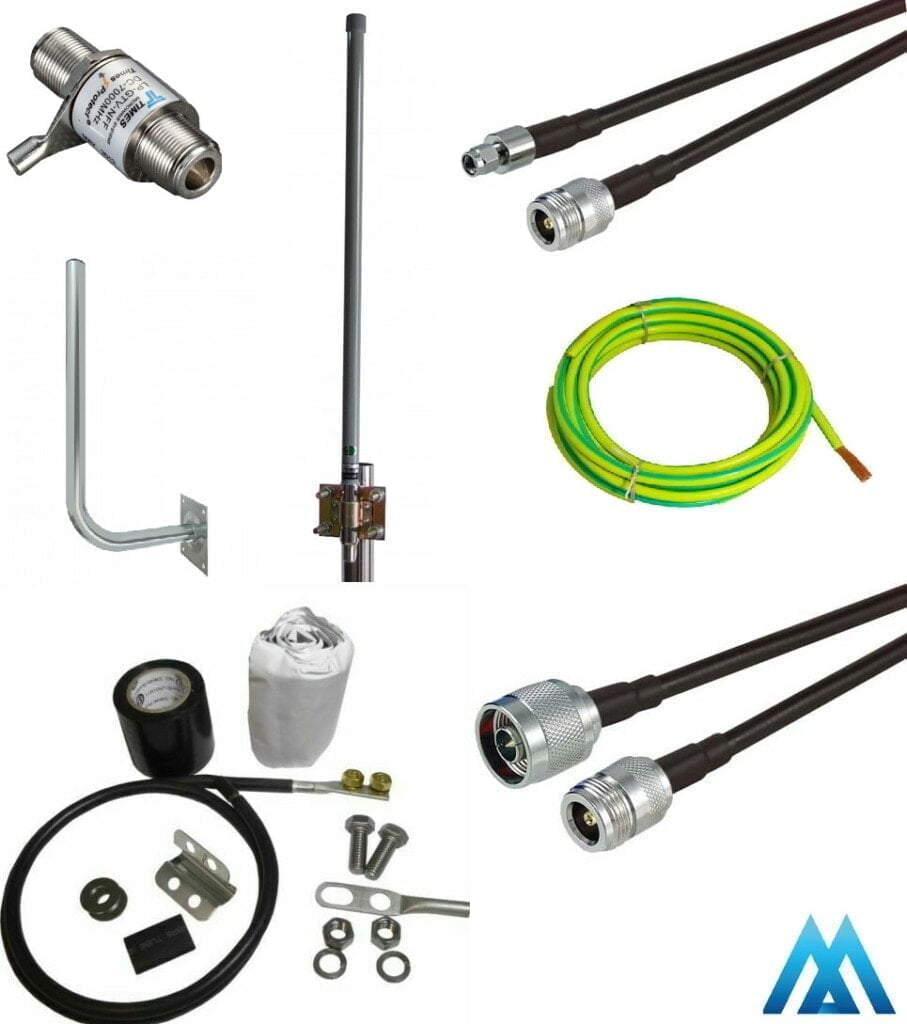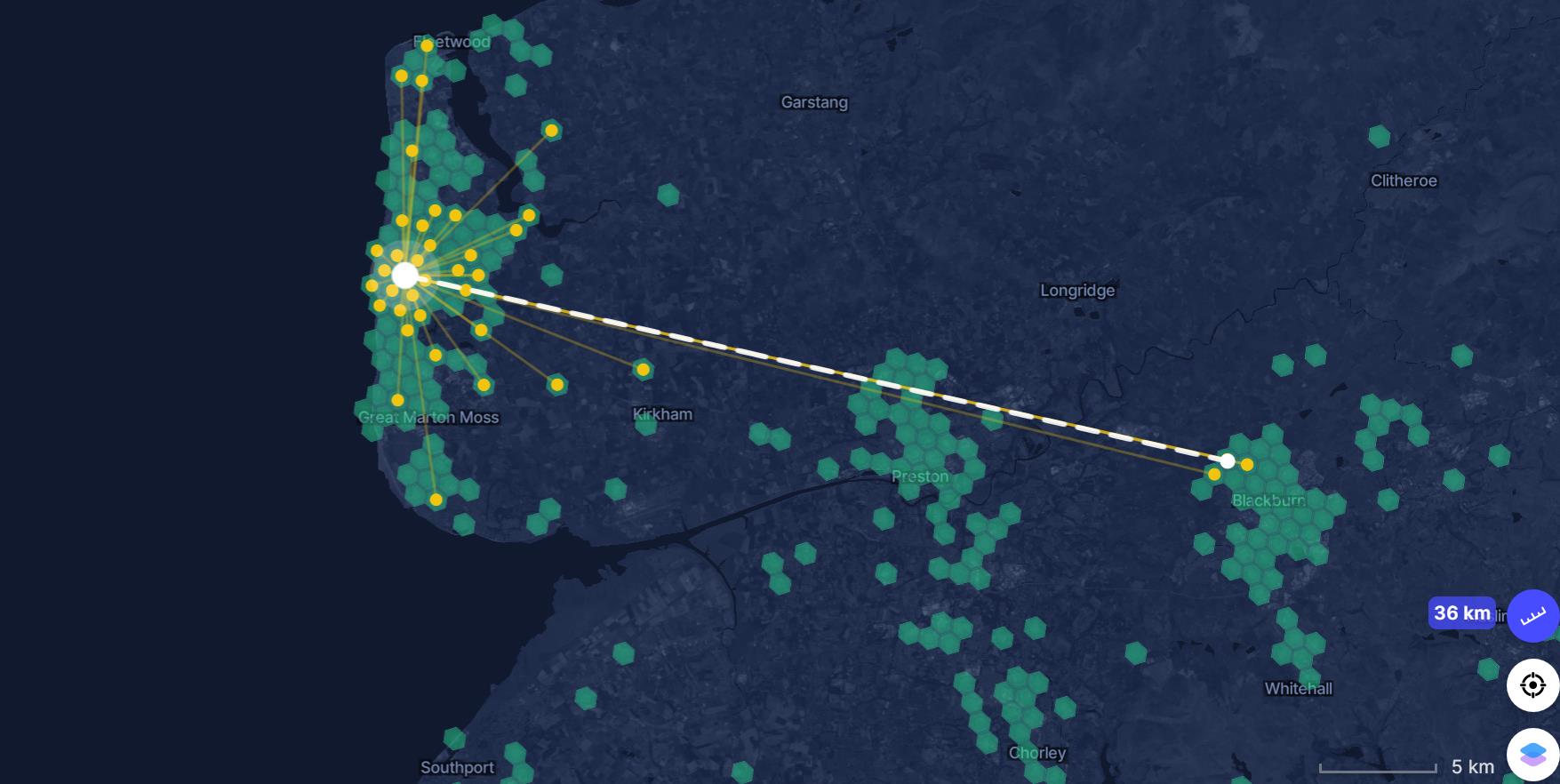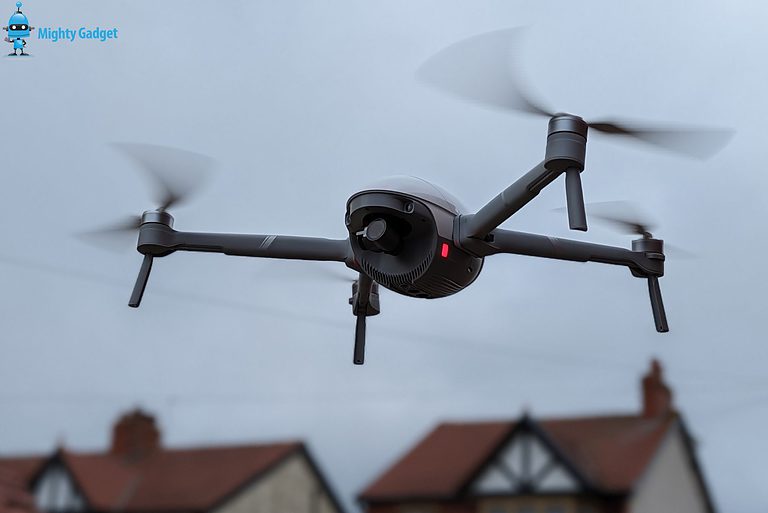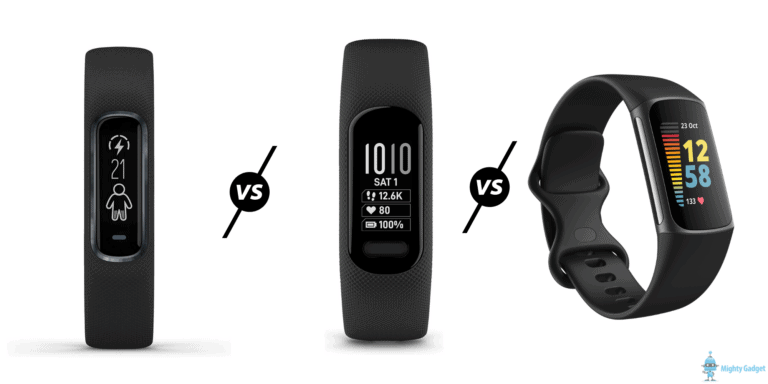Any links to online stores should be assumed to be affiliates. The company or PR agency provides all or most review samples. They have no control over my content, and I provide my honest opinion.
For whatever reason, it didn’t occur to me to review the Mcgill Microwave Systems Full Helium Installation Kit when I first bought it. So, I didn’t document or take many photos, so it is a bit of a limited review, but I think it is worth writing about regardless.
My Helium hotspot has done OK for me in the past, but not as good as others. In hindsight, I should have paid for a decent quality kit and a professional install to start off with.
The Mcgill Microwave Systems Full Helium Installation Kit is designed to offer everything you need for a roof-mounted antenna. This includes:
- Optimised EU868 6dBi antenna
- Zinc Plated heavy duty antenna wall bracket
- Ultra Low Loss LMR-600 Cable Assembly (10 metres long, fitted with N Female and N Male Connectors) – From Antenna to LP Device
- Ultra Low Loss LMR-400 Cable Assembly (3 metres long, fitted with N Female and RP SMA Male Connectors) – From LP Device to Helium Device
- LP-GTV-NFM Times Protect Lightning Protection Device.
- 20 Metres of Earth Cable
- GK-S600TT Ground Kit
- Antenna mounting brackets

LMR-600 Ultra Low Loss Cable
It is perhaps the LMR-600 Ultra Low Loss cable that is the most interesting part of this review. This LMR-600 is exceptionally thick, far larger than any other cable you will likely see in a consumer installation. The outside diameter is 15mm whereas the LMR-400 cable is 10.3mm, the generic cable you buy from Amazon is even thinner.
The LMR-600 offers a massive reduction in signal loss compared to other cables:
- RG-58 cable RF Signal Insertion Loss over 10 Metres at EU 868 MHz Frequency is nominally 5.2 dB (that’s only 56.4% efficiency)
- LMR-600 Loss over 10 Metres at EU 868 MHz Frequency: 0.9dB (Much higher coverage, 83.1% efficiency!)
One thing you should be careful with is the length of this cable. 10M is fine for most homes, but when it came to installation, the off shape of my roof meant I didn’t have enough length to reach my 1st floor room from the chimney, so I had to mount it and the high spot of the roof on the fascia board.
Also, just to highlight be as clear as possible, this cable is VERY thick, you will need cable clips that can fit it. If you have a TV antenna installer come and fit this, they almost certainly won’t have clips big enough.
LMR-400 Cable
This cable is included as it is much thinner, making it more feasible to route into your home. I wouldn’t really want a 15mm+ cable drilling into my house for the LMR-600.
Optimised EU868 6dBi antenna
This is a surprisingly small antenna for 6dBi, I had planned to use the Paradar 8dBi antenna but realised this has an N Male connector rather than N Female of the Paradar. Again, if you plan to use something different than the supplied antenna, you are best speaking with Mcgill Microwave.
Lightning Protection Device
Most UK TV antennas don’t use lightning protection devices, so my antenna guy was a little stumped as to where to install this. Considering you have likely waited months for your Helium Hotspot, it is worth installing just to be safe.
Performance
I was previously using the Paradar 8.5dBi antenna using LMR-400 cable but a bit lower down at gutter level. I had planned to carry on using it but realised the connections were different so I went with the Mcgill antenna.
In the new slightly higher and more exposed position, the number number of witnesses I had increased over the week and currently sits at 53, which is more than double what I had previously.
From the start of September through to late September, my daily earnings had decreased to 0.2 and 0.4HNT per day. Since installing this antenna, this has increased to between 0.4 and 9.9HNT per day—more than double the performance.
Previously, I’d get the occasional witness that is miles away. This would sometimes be one based in Barrow In Furness, so the signal crossed 33km over the sea to Blackpool.
However, now I had a much higher density of local hotspots plus three going out as far as Blackburn which is measuring at 36km. I then have another 5 that sits around 10km away from me.
Overall, I am very happy with the kit. It is not cheap at all, and I was worried it wouldn’t offer that much benefit and the ROI would be minimal, but it looks like it will pay itself off in a couple of months. I just wish I had forked out the money to do things properly a year ago!
Mcgill Microwave Systems Full Helium Installation Kit EU868 6dBi Review Rating
Summary
The Mcgill Microwave Systems Full Helium Installation Kit has everything you need to set up an external Helium Hotspot antenna. The ultra-thick and ultra-low loss LMR 600 cable minimise signal loss ensuring the best possible mining performance. It is not cheap but it is more convenient than sourcing the individual components yourself and it is extremely likely you will get a positive return on investment from it.
Overall
90%-
Overall - 90%90%
Pros
- Best possible performance from your Helium Hotspot and it will almost certainly provide a positive return on investment
- The full kit has everything you need so it should be easy enough for the antenna installer to fit it
Cons
- Expensive
- Thick cable is difficult ot work with & you will need a decent-sized hole drilling for the LMR 400 cable into your house
- Supplied cable lengths may not fit your house perfectly
I am James, a UK-based tech enthusiast and the Editor and Owner of Mighty Gadget, which I’ve proudly run since 2007. Passionate about all things technology, my expertise spans from computers and networking to mobile, wearables, and smart home devices.
As a fitness fanatic who loves running and cycling, I also have a keen interest in fitness-related technology, and I take every opportunity to cover this niche on my blog. My diverse interests allow me to bring a unique perspective to tech blogging, merging lifestyle, fitness, and the latest tech trends.
In my academic pursuits, I earned a BSc in Information Systems Design from UCLAN, before advancing my learning with a Master’s Degree in Computing. This advanced study also included Cisco CCNA accreditation, further demonstrating my commitment to understanding and staying ahead of the technology curve.
I’m proud to share that Vuelio has consistently ranked Mighty Gadget as one of the top technology blogs in the UK. With my dedication to technology and drive to share my insights, I aim to continue providing my readers with engaging and informative content.








How about that ey! Barrow in Furness here ???? installing 2 X mcgill antennas in the morning. ???? We make it across the pond a bit more.
What differences did you find between this antenna and the paradar?
I am referring to the materials, I was evaluating the difference between the 7.5 dbi of the Mcgill and the 8.5 dbi Paradar, I wanted to understand if it is worth the difference in price. Is the section different? How about The swing in case of strong winds, you found big differences ?
Thanks for your review
Build quality feels about the same, they are both fibreglass and feel sturdy. I currently have the McGill on my roof and it has had no issues with the recent winds.
The main difference is that the Paradar uses an N-female connector rather than male. This is the only reason I switched to the Mcgill, because the cable I bought from them was for the standard male connection on most antennas, I didn’t want to use an adaptor and potentially introduce more signal loss.
Paradar has the backplate premounted to it too, which I guess makes it a little easier to install.
I can’t really compare the performance as I only started using the McGill when I move the antenna to a higher spot and used their LM600 cable.
Hi James, I just wanted to say thanks. If I hadn’t stumbled into your blog posts here today, I would have no doubt been sitting in a very long queue waiting for my overly-priced, under-optimised miner to arrive.
Really happy to say that I rang McGill earlier for advice and had the pleasure of speaking to Billy, a VERY knowledgeable and passionate chap indeed. I know where I’ll be spending my money 😉
Cheers,
Rich
Looks like I will need to do the same. Now to fin someone to instal it for me.
By the way, I assume that the only antennas worth buying are the 4dbi ones? or the 4.5dbi from paradar?
I just phoned a company that does TV antennas, cost me about £70 for the installation. Which in hindsight I should have done when I first got my hotspot!
I did this the other day, told them it was a Helium Antenna, I was quoted £195 :)))
I might as well go hire a roof ladder and do it myself. I am trying other companies, wondering if I should just tell them it is a Netgear WiFi Extension Antenna. The moment they hear Cryptocurrency, they think you are printing money.
With the current updates, it will be a while before I even break even.
I found someone for £100. I just need to buy the kit.
What do you suggest?
1) mcgill microwave 4dbi
2) mcgill microwave 6dbi
3) paradar 4.5dbi
4) paradar 6.5dbi
Another TV Aerial installer, I told them it was a Helium Antenna, and they said £250.
Wow, there are some rip off merchants where you live. £100 isn’t too bad though.
My 6dbi antennas seem to perform better than the 3dbi, but in general I haven’t experienced THAT much difference.
6dbi is probably the safe bet
It is, for this money I might as well hire the gear and do it myself, I have all the tools I need anyhow, but wanted someone that knows how to get on the roof. The last think I want is to fall through it, or damage the roof or the chimney.
Have you looked into what pole/antenna masts you can use in general? What would be the longest safest pole I can put up on the house?
For the one on my house I used the mast that came with the Mccgill kit, it doesn’t add a huge amount of height, for the others I have reused the existing TV antennas
I have seen a couple of houses with wall mounted masts with very large poles. This is the best I could find quickly but V expensive. https://www.mm0cug.co.uk/shop/aluminium-masts/
I didn’t get anywhere. I finally got an Aerial specialist that won’t charge an arm and a leg to come round, was supposed to be today, when I realised the kit I got from mcgill microwave has the wrong connectors. So I am now left with 15m of LMR600 that can’t be used and gotta re-order, plus an adaptor if I decide to use the 15m in the future.
I had the miners for 2 months now and didn’t get to do anything with them:)))) Should have just purchased them huge poles you linked to, and do it myself next to the wall of my terraced house.
I am now seeing a lot of videos of people stating that 8dbi antenna might be better. I only got the 4dbi:)))
I should point out that I ordered the wrong kit, because the mcgillmicrowave website was not clear on what to get, back in February, it seems to be much more noob friendly now. Also I couldn’t get hold of anyone on the phone for days of trying so I just placed an order. I did not try to e-mail them.